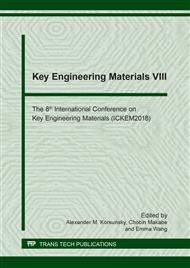p.260
p.266
p.272
p.278
p.283
p.291
p.298
p.305
p.311
Comparison between Carbon Nanotube-Based, Graphite-Based, and Rice Hull Carbon-Based Electrodes with Rice Hull Silica as Catalyst for Electrochemical Detection of Copper
Abstract:
This study aimed to determine the copper ion-sensing ability of a carbon nanotube (CNT)-based sensor with carbonized rice hull (CRH) as catalyst. The 50:50 CNT-CRH electrode was compared to 100% graphite, 100% CRH, 100% CNT, 50:50 graphite-CRH, and 70:30 graphite-CRH electrodes. Copper chloride (CuCl2) concentrations of 0.01M, 0.02M, 0.03M, 0.04M, 0.04M, 0.05M, 0.06, 0.07M, 0.08M, 0.09M, and 0.1M were used to test the response of the electrodes. Five trials were done for each concentration. The 50:50 CNT-CRH electrode exhibited good sensor characteristics such as high sensitivity, low resolution, and high correlation in concentration-voltage relationship. Electrical characterization using three-electrode system showed a linear relationship between the concentrations and voltage response. The 50:50 CNT-CRH electrode exhibited a sensitivity of 0.0619 V/0.01M or 9.7 mV/100ppm and a resolution of 10 ppm/1mV. The electrode also exhibited a high correlation R2 value of 0.933.
Info:
Periodical:
Pages:
283-288
Citation:
Online since:
August 2018
Price:
Сopyright:
© 2018 Trans Tech Publications Ltd. All Rights Reserved
Share:
Citation:


